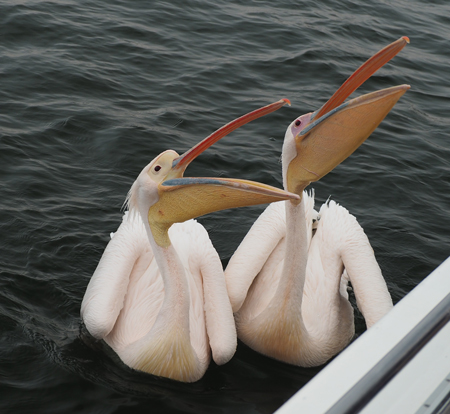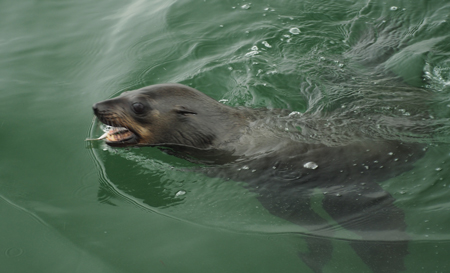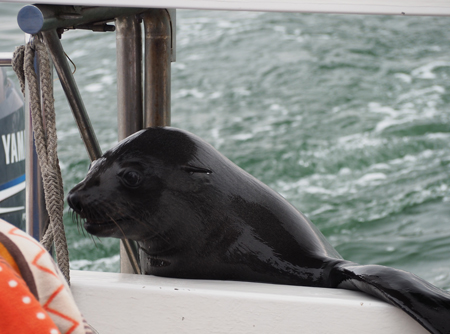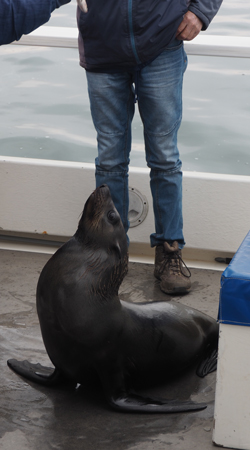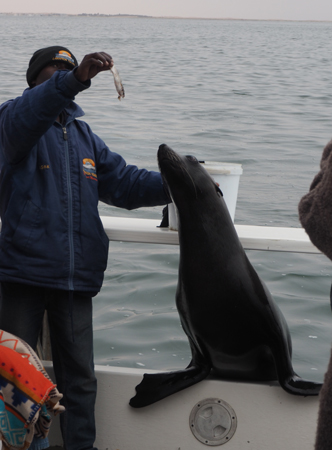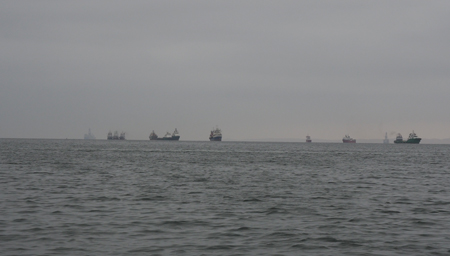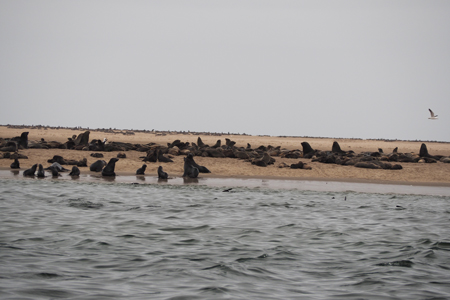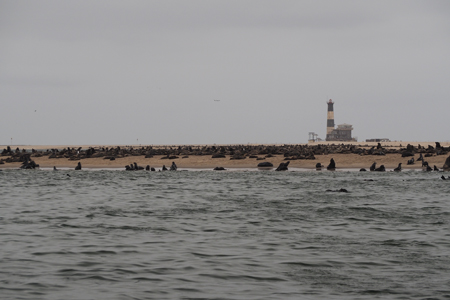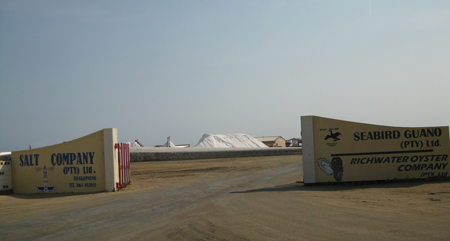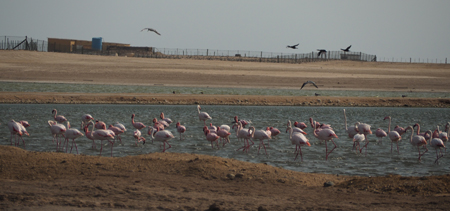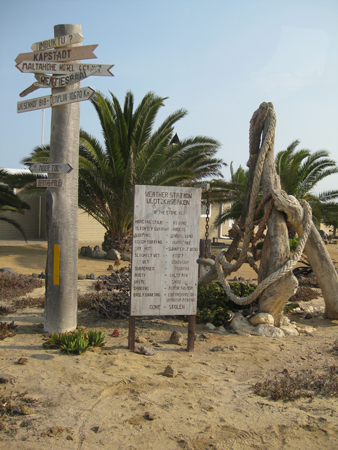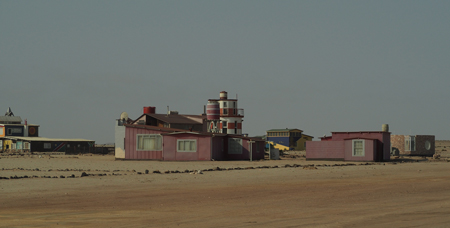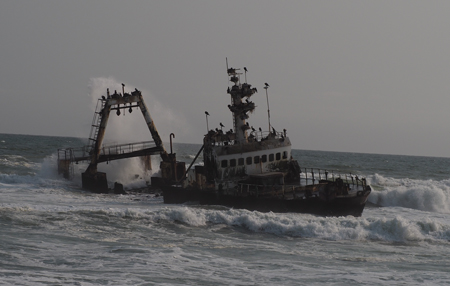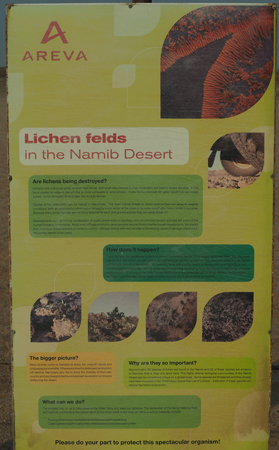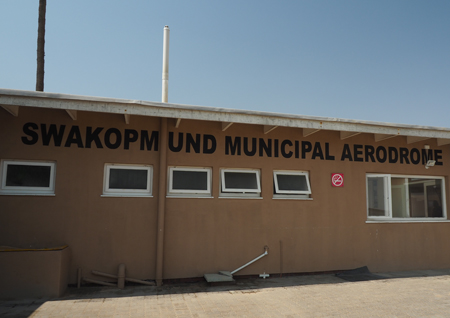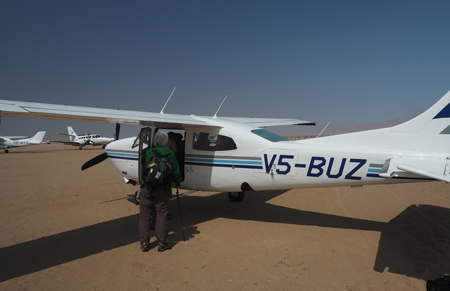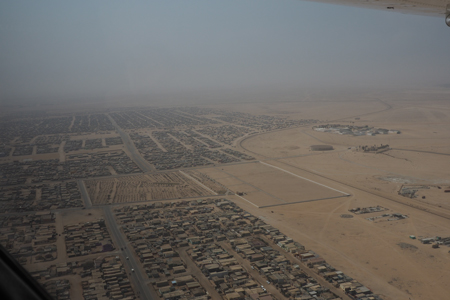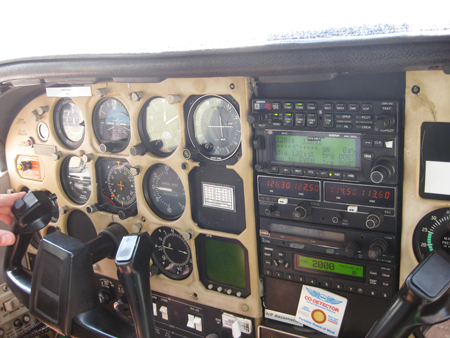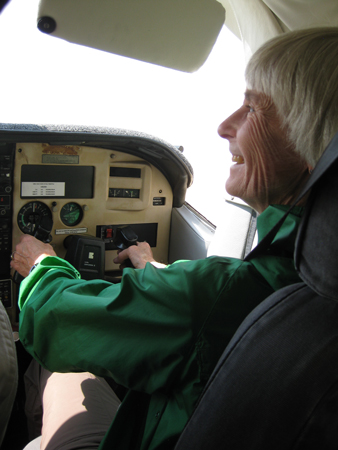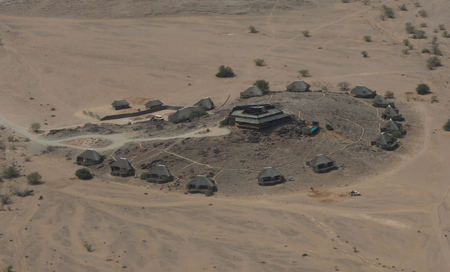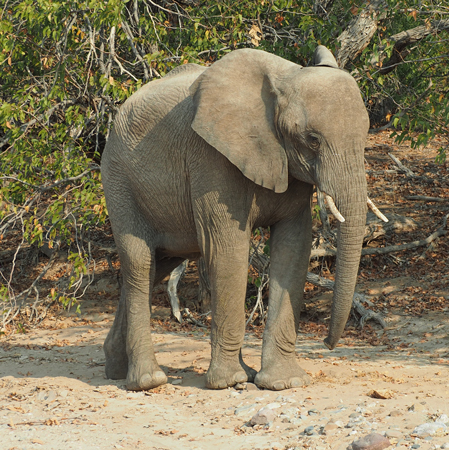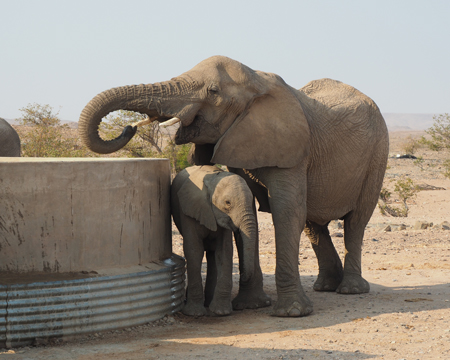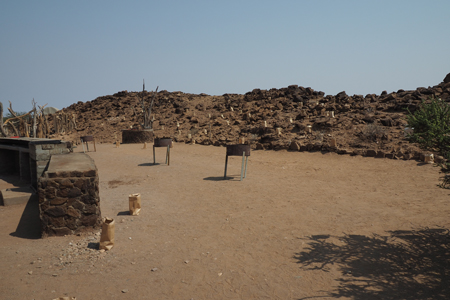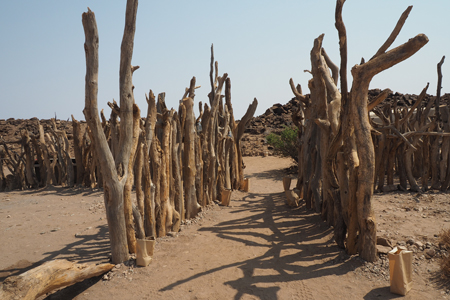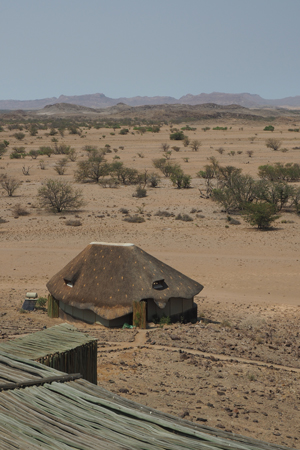Tues., 8/29/2017 – Swakopmund
We had a tour of the lagoon at Walvis Bay this morning on a small catamaran with six others (4 from South Africa and 2 Japanese). We were told to dress warmly so we had on our quilted jackets, then our fleece jackets, and then our OAT jackets, ski hat, and gloves. We were given little blankets for our legs - all were needed!
The captain and mate used fish to attract great white pelicans to the side of the boat. The male pelican has purple coloring around his eyes and the female, pink.
The seals came around our boat wanting fish from the mate. Some of them even jump over the stern board right onto the deck.
We passed a large oyster farm. Barrels are roped together in a line and baskets with small seed oysters inside hang from the lines. They grow fast in this lagoon because of cold water and lots of plankton.
A 9:30 we were treated to Old Brown sherry. It tasted like our old Cheracol cough syrup. Then we got near the sand spit that protects the lagoon from the Atlantic. It is estimated that there are 80,000 to 100,000 Cape Fur seals here in the sea and on the sand of Cape Cross. They come here to breed. (These seals are actually a species of sea lion.) It smelled terrible! We didn’t stay long..
Then we raced out to get the Heaviside dolphins to swim in our bow wake. It was hard (impossible) to get a picture of them surfacing.
We were served lunch on our way back to the dock. Champagne and raw oysters were the big draw – Marge enjoyed that. I ate a few meatballs, spring rolls, and chicken strips with two boxes of juice. It was three hours of fun and a break from game drives and city slums.
Pelicans
Pelicans
Seal
Seal coming to beg
Begging seal
Begging seal
At anchor in Walvis Bay
At anchor in Walvis Bay
Oyster farm in Walvis Bay
Seals on the sand at Walvis Bay - very smelly!
Seals on the sand at Walvis Bay
At 2:30 we drove north along the Skeleton Coast. It is called that because of the shipwrecks that happened here because of the thick fog and ships running aground on the shallow sandy bottom. The Coastal Road surface is compacted sandy soil and salt.
We drove over sand for a closer look at the saltpans where ocean water is left to evaporate and then the salt is bulldozed into piles and processed. Next to the salt factory is a guano factory. Cormorant guano is collected and made into fertilizer. There is also an oyster factory adjacent. We saw lots of flamingoes in the saltpans.
Salt and Guano companies - hope they can tell the difference!
Salt company
Flamingos
We drove in and around a very unique ECO village - Wlotzkasbaken. There are no electric lines or water pipes or flush toilets. Water is trucked in to fill tanks above the house roofs. Every house uses solar power now. The village began with South African fishermen making holiday retreats in the 1960’s. All of the houses were painted different bright colors. There are no stores or entertainment other then surf fishing. It is probably very peaceful.
We got out of the van to take pictures of the Zeila, the latest ship to run aground (8/25/2008) on the Skeleton Coast.
We also stopped at a lichen field. The lichen (algae and fungi) survive on moisture from the fog. Lloyd sprinkled water on some lichen and the “leaves” opened up and turned green.
Wlotzkasbaken
Wlotzkasbaken
Skeleton Coast - Zeila Shipwreck
Lichen Fields sign
Wed., 8/30/2017 - Swakopmund to Damaraland
We had a leisurely breakfast this morning because we weren’t leaving for the airport until 10:45. This also gave us time to take a stroll around town. We walked to the Strand, through the outdoor craft market, and out the fisherman’s jetty into the ocean. The tide was in and the breakers were sending spray up onto the walkway.
At 10:45 we all left for the Swakopmund Airport. There was one 12-passenger plane and a half dozen baby Cessnas for 6 people. Most of the group went in the “big” plane and three of us and Lloyd squeezed ourselves into a little one. Gale got to sit in the copilot seat and got to see everything. It was cool!
After our arrival at Doro Nawas Lodge, we assembled on the veranda for a late lunch of starter (zucchini quiche), oryx steak, and lentils with ice cream for dessert.
Swakopmund Airport
Swakopmund Airport - our little 6-seater
Dantago Community from the air
Flight to Damaraland
Flight to Damaraland
Flight to Damaraland
Flight to Damaraland
Doro Nawas camp from the air
After lunch, we set out on a game drive to find the special desert adapted elephants that live in this terribly arid place. As we drove around I felt like we were on the surface of the moon!
We passed our airstrip and then the “village” of a tribe from South Africa that moved here in 1973. They are what our guides call farmers but they are really herders of cows, sheep, and goats. Our driver, Ballock, saw fresh elephant dung and followed it until we spotted six desert elephants on their way to a water trough. Since there is no water in any “rivers” and most water holes are dry, the government has dug wells and built a round tank and pool and a concrete trough to water animals. Elephants used to knock down the village water tanks. These new water tanks and pools are shared by herds, people, and wild animals. We watched as the four adults and two youth stuck their trunks over the side of the pool and drank. The baby had to put its front feet on the edge to get its trunk in the water. We watched them for a long time.
The desert elephants have smaller bodies, longer legs, shorter tusks, and bigger feet to contend with walking on soft sand.
Native village
Desert Elephants
Desert Elephants
Desert Elephants
Desert Elephants
Dinner tonight was a “bush buffet.” The lodge sets up a long table next to a steep hill set up with paper bag luminaries, a fire pit, and buffet line. We had “kettle soup” – carrot soup served in little cast iron kettles – and then the women were invited to be served at the buffet before the men. Several African countries have this tradition, which I really like. We had sausage or chicken or lamb chops, polenta, green beans, and some other African things. Dessert was apple crumble. It was an entertaining dinner.
Site of Doro Nawas' dinner BBQ
Site of Doro Nawas' dinner BBQ
Site of Doro Nawas' dinner BBQ
Our tent at Doro Nawas
| Return to Top | Return to Itinerary | Return to Trips page to view other trips | Return to Dreamcatcher Home Page |

